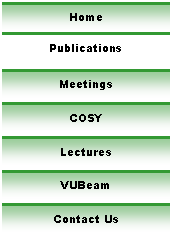
|
Reprint Server |



Application of Rigorous High-Order Methods and Normal Forms to Nonlinear Systems
Abstract
The nonlinearities of dynamical systems often display the most interesting and fascinating behavior. At the same time, those nonlinearities complicate finding closed form analytic solutions, especially for complex systems, to the point where it is often impossible. Differential algebra (DA) based methods allow us to analyze those systems with all their nonlinearities up to arbitrary order in an automated, computer based framework that operates with floating point accuracy.This thesis will investigate repetitive dynamical systems from seemingly unrelated fields of study using DA methods such as DA based transfer and Poincaré maps, the DA normal form algorithm, normal form defect studies, and verified methods based on Taylor Models. The common mathematical underpinnings of those dynamical systems allow us to analyze them with different techniques that have the same methods at their core.
Specifically, we will analyze resonances, associated fixed point structures, and oscillation periods of particles in the accelerator storage ring of the Muon g-2 Experiment at Fermilab to gain a detailed understanding of the stability of the system and the potential loss mechanism of particles. If successful, the Muon g-2 Experiment raises existential questions about the completeness of the Standard Model of particle physics, which makes our efforts to understand the stability of the system highly relevant.
The same methods used for the analysis of the accelerator storage ring will also be used to generate far reaching sets of satellite orbits for formation flying missions under the Earth's gravitational zonal perturbations. Our approach is particularly elegant and precise, and its theoretical limits are beyond the range of practical applications.
One central method in both of those analyses is the DA normal form algorithm. Using the mechanical device of the centrifugal governor as an illustrative example problem, the special properties of the resulting normal form, the sensitivities and limitations of the algorithm, and its resulting quantities are explained in detail.
We also will provide first results and an outlook for future work of the presented methods in the realm of verified methods, and illustrate the current possibilities as well as future opportunities and challenges. In particular, Taylor Model based verified global optimization is introduced and used to calculate rigorous stability estimates for different configurations of the Muon g-2 Storage Ring.
A. Weisskopf (2021)
Download
Click on the icon to download the corresponding file.
![]() Download Adobe PDF version (33633936 Bytes).
Download Adobe PDF version (33633936 Bytes).
Go Back to the reprint server.
Go Back to the home page.
This page is maintained by Kyoko Makino. Please contact her if there are any problems with it.